Tag: Championing ecological research
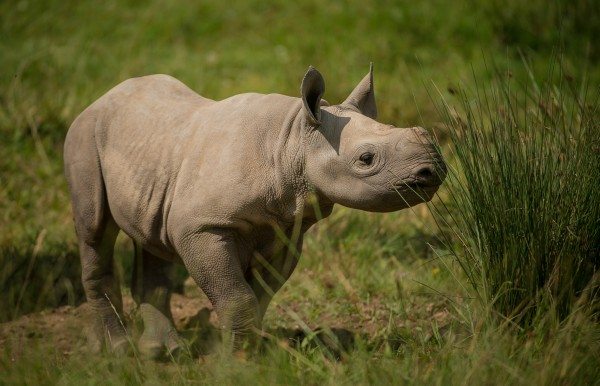
Rhinos face severe threats in the wild, so understanding their social and breeding behaviours is becoming increasingly important in order to conserve this species. Becky has spent her time with Chester Zoo studying our eight eastern black rhinos and recording their scent marking behaviours.
Scent communication is an important factor in the social lives of many species, and often plays an important role in breeding success. Becky watched 480 hours of video footage of our rhinos using our CCTV cameras to get an idea of how they use scent to communicate. She found that urine spraying was a very important part of communication between the rhinos; when they moved habitat or another individual was introduced, the urine spraying increased. Becky says:
If you are a zoo looking at mixing male and female rhinos, then giving them access to each other’s scent to allow them to get that bit of information about each other before they actually meet is really important! That way once they are introduced in the same habitat they are not strangers and already know about each other.
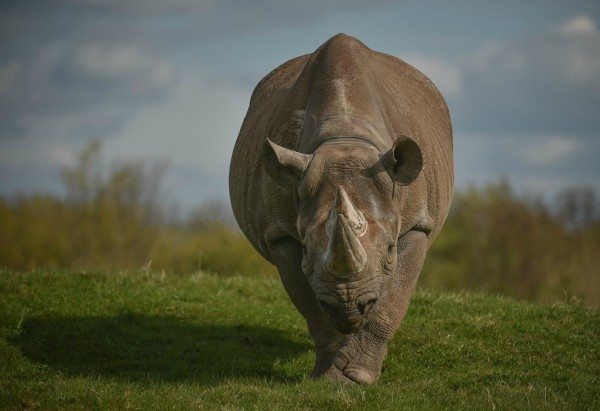
Becky’s results suggest that urine spraying is not only a way of the rhinos marking their territory, but is also a ‘scent cue’ used to inform other rhinos who else is in the area. She found that these scent cues were likely to increase when the rhinos were sexually active in order to attract a mate.
Chester Zoo first started working with the endangered Ecuador Amazon parrot back in the 1980s when a collection of individuals were confiscated at customs and distributed to a number of zoos across Europe to be cared for. Since then, they have become part of an Endangered Breeding Programme, which is managed by Chester Zoo.
The Chester Zoo team have been working in Ecuador to assess the current population of the parrots, as well as their habitat. They’ve also been hard at work installing nest boxes and working with the local community to increase their understanding of the parrots’ behaviour.
Our project partners, Fundación Pro-Bosque, are based in the dry forests of the Cerro Blanco, running assessments and also protecting the forest from fires, hunters and other threats to the ecosystem. We’re also working with local independent biologists with invaluable knowledge of the area and the animals.
Watch the video below to find out all about our conservation work in Ecuador, why the Ecuador Amazon parrot is important, and how you can get involved to save them.
In the below video, the team share their experiences of what it was like to work in the hot and humid dry forests of Ecuador, and the vital conservation work being done to protect the endangered Ecuador Amazon parrot from extinction.
“The Pantanal is the world’s largest wetland and, at its peak, is thought to cover an area the size of Greece! The region is a haven for wildlife lovers and I was thrilled to wake up on my first morning to the sound of wild hyacinth macaws squabbling with each other outside. The Lowland Tapir Conservation Initiative (LTCI) is studying tapirs across different habitats within Brazil.
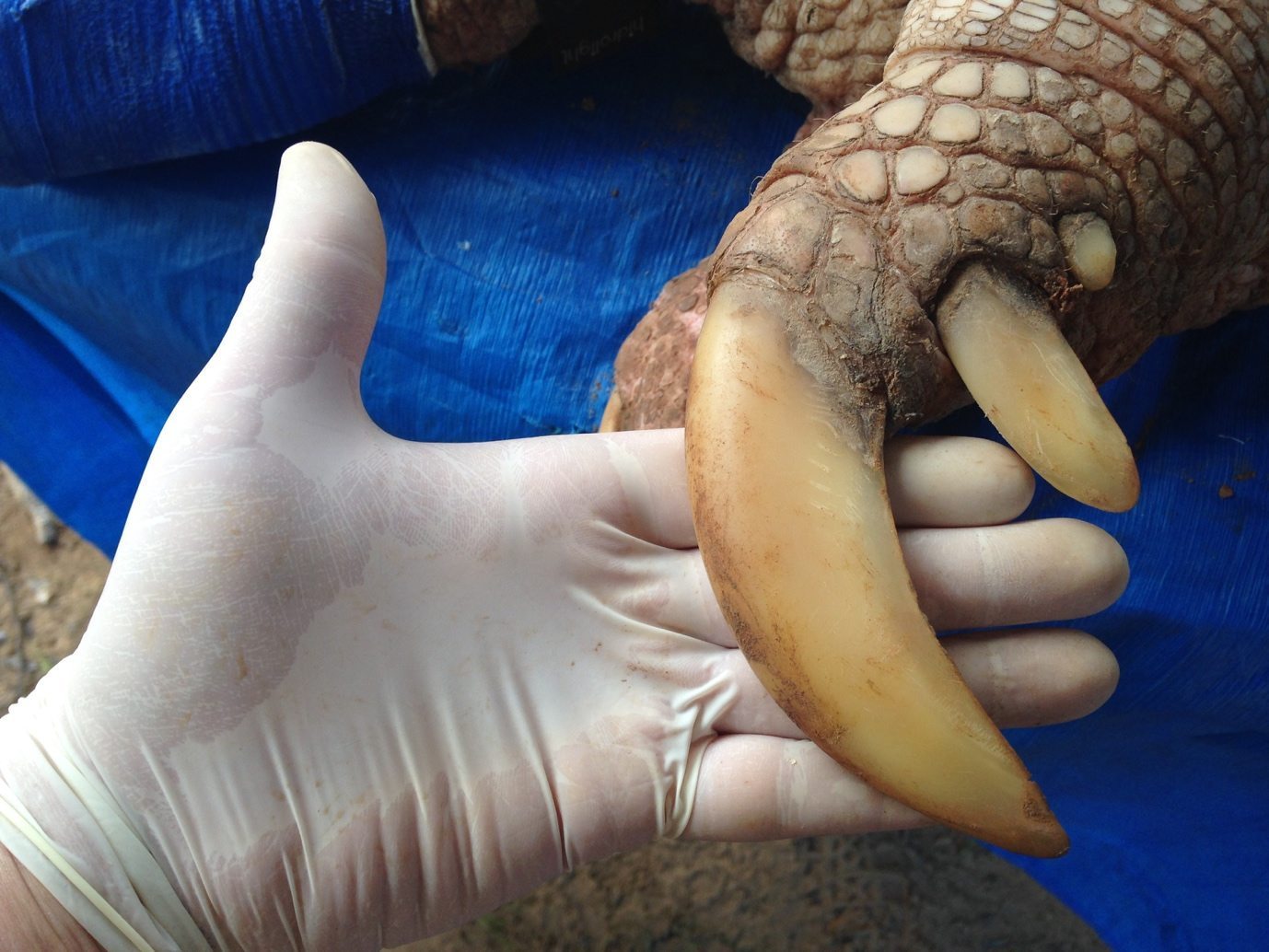
“Over 95% of the Pantanal is privately owned and mostly used as agricultural land for cattle-ranching yet the study site is considered to be pristine tapir habitat. In contrast, the huge grassland expanse, known as the Cerrado, which covers most of southern Brazil, is being heavily targeted for human development. By comparing population trends and identifying threats to tapirs in different areas, the LTCI is able to work with stakeholders in order to help mitigate risks to them.
“During my time in the Pantanal, I helped the LTCI with its ongoing studies into the social and spatial ecology of lowland tapirs. Each morning, after a breakfast of milk and liver covered with breadcrumbs, we would head out and check each of the sixteen box-traps set throughout the 100km2 study area. The tapirs that we caught were anaesthetised in order to perform a full health examination and collect biological samples such as blood, body tissues and parasites. Certain individuals were also fitted with a radio-collar and, alongside the use of camera traps, we were able to monitor the movements of several animals. The LTCI has been collecting information on wild tapirs for over 20 years and this huge amount of data is helping to determine biological parameters such as the time interval between births, infant mortality rates and fertility rates within the population. This information is needed in order to determine how sustainable a population is likely to be.
Daytime temperatures were regularly above 40°C, making it hard and tiring work but, having worked with several lowland tapirs at the zoo, it was a wonderful and humbling experience to get hands-on with those in the wild.
“My afternoons and evenings were then spent working alongside members of The Giant Armadillo Project. Very little information is known about these labrador-size, prehistoric-looking creatures but studies suggest that their wild population has reduced by 30-50% over the past 30 years. The Giant Armadillo Project is helping to discover more information about the ecology of this rare and elusive species in order to help identify and reduce the threats to it.
“Each day, as the sun started to disappear over the horizon, the team and I would head out on the back of a 4×4 truck, using radio-telemetry to locate previously identified armadillos. If an unknown armadillo was found, we would carefully capture and anaesthetise it in order to perform a full health examination, collect biological samples and place a radio-transmitter and GPS device. Such information and observations have shown that male armadillos may have home ranges of up to 40km2 and that the burrows they dig can be used by over fifty different species of mammals, birds and reptiles. The discovery that giant armadillos are such important ‘ecological engineers’ means that by preserving them in an area, several other species will also benefit and hopefully thrive.
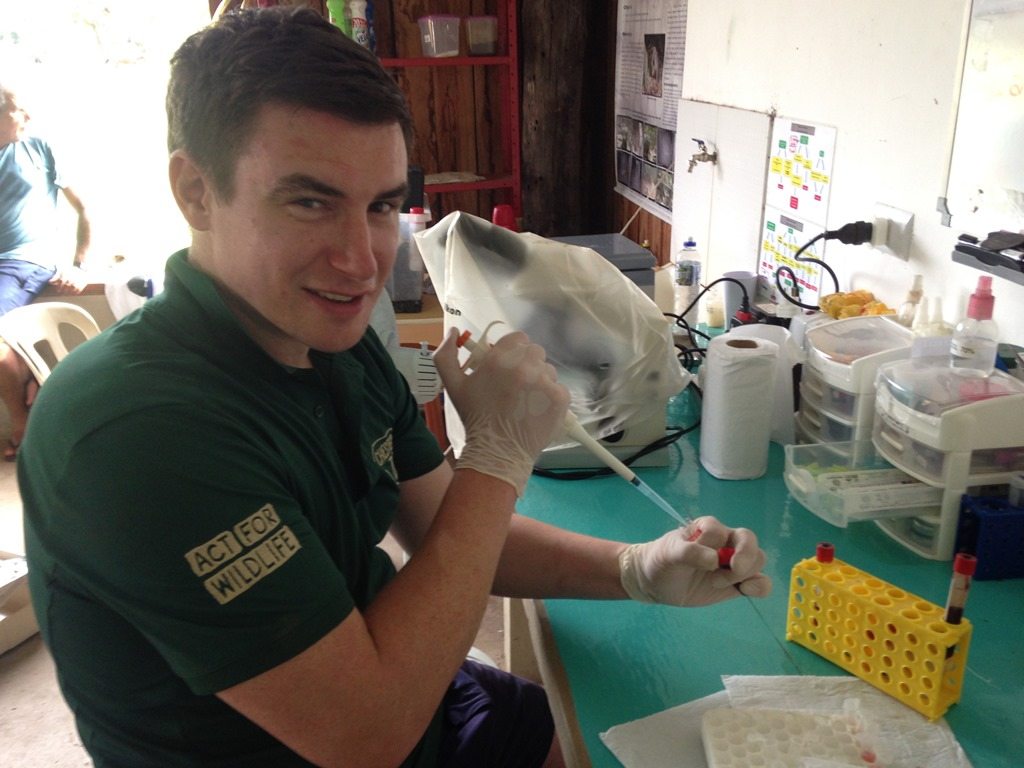
“Having wanted to visit the Pantanal since I was a young boy, it was a huge privilege and a dream come true to see the amazing work being carried out by both projects and to appreciate how Chester Zoo is helping to Act for Wildlife around the world. As well as tapirs and armadillos, I was fortunate to have encounters with wild giant anteaters, caiman and capybara plus so much more! It was a truly wonderful experience which I will remember forever.”
We’re leading the way
We’re at the forefront of the conservation work needed to help save the endangered Ecuador Amazon parrot from extinction. Following years of research carried out by Chester Zoo’s Chief Executive Officer, Dr Mark Pilgrim, the bird was only officially recognised as a species in its own right in 2014.
Chester Zoo first started working with the endangered Ecuador Amazon parrot back in the 1980s when a collection of individuals were confiscated at customs and distributed to a number of zoos across Europe to be cared for. Dr Mark Pilgrim’s interest in the species was sparked when he first started working at the zoo as a Bird Keeper. He spent time tracing the birds that came to the UK which later developed into the European Association of Zoos and Aquaria (EAZA) Endangered Breeding Programme for the parrot; which Chester Zoo now manages. The conservation breeding of the species in zoos is vital in ensuring there’s a physically and genetically healthy insurance population, should the species go extinct in the wild.
Tracing parrots
Technical Assistant to the CEO and Chester Zoo Conservation Scholar, Rebecca Biddle, has spent several years researching this species as part of her PhD to answer questions about this secretive bird. She has spent many hours trekking through the forests of Ecuador on the search for sightings of this green parrot to discover how many there are, how big their range is and what habitat they depend on.
One element of Rebecca’s work is to organise a staff expedition every three years to the Cerro Blanco forest as part of long term research into the Ecuador Amazon parrot population. The first expedition took place in 2014, which led to the IUCN listing the species as ‘Endangered’.
Earlier this year a team of twelve Chester Zoo staff members went back to the tropical dry forest of Ecuador on the lookout for this parrot species; continuing the ongoing, long term research that started over five years ago. The team’s main objectives were to gain sightings of the parrot, collect data on their habitat, conduct roost counts and trial the first community surveys.
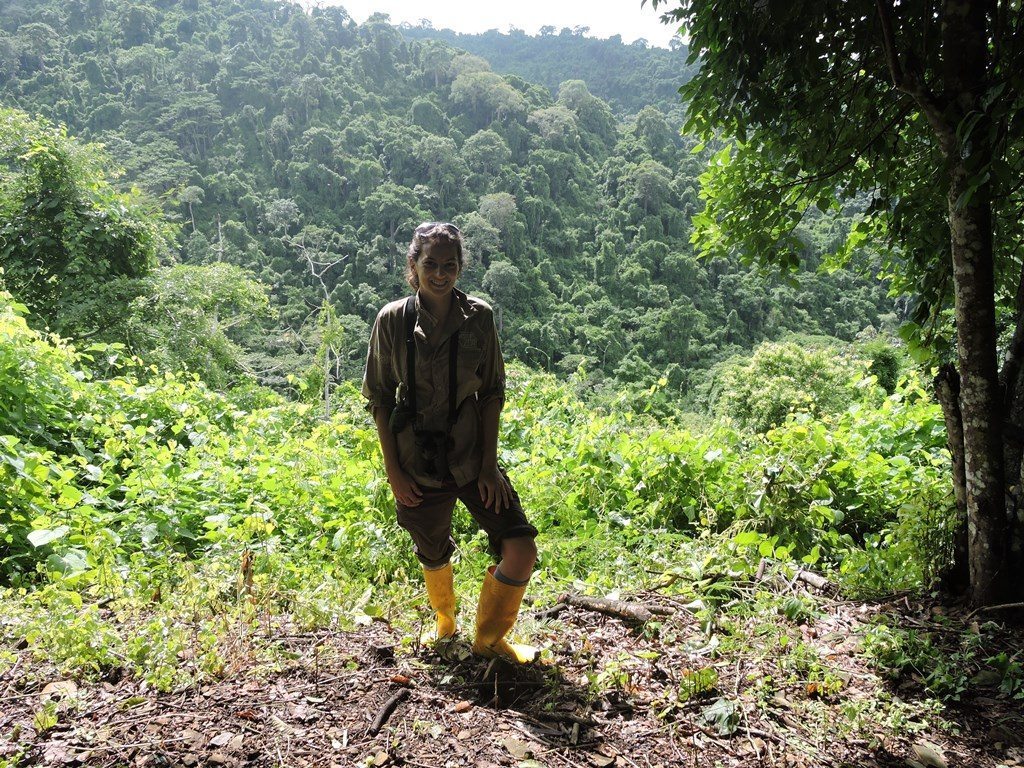
Roost counts
Every morning the team would be up and out before sunrise to count the parrots as they left their communal roost. They also counted the birds as they returned to their roost each evening. Having a team of twelve also meant more data could be captured as the group split into smaller teams to get counts from different roosts at the same time. This is important as we’re trying to determine whether the parrots change their roosts throughout the year or stay loyal to the roosts.
While doing the roost counts the team also noted whether the parrots were flying in pairs, on their own or in triplets. By capturing this information as well as the total amount of birds spotted, we can now investigate whether roost composition can provide us with an idea of the reproductive success of the population. The species can live up to 40 years, so this information is extremely important, as if we can’t see any reproduction happening, it’s possible to end up with an aging population that suddenly crashes.
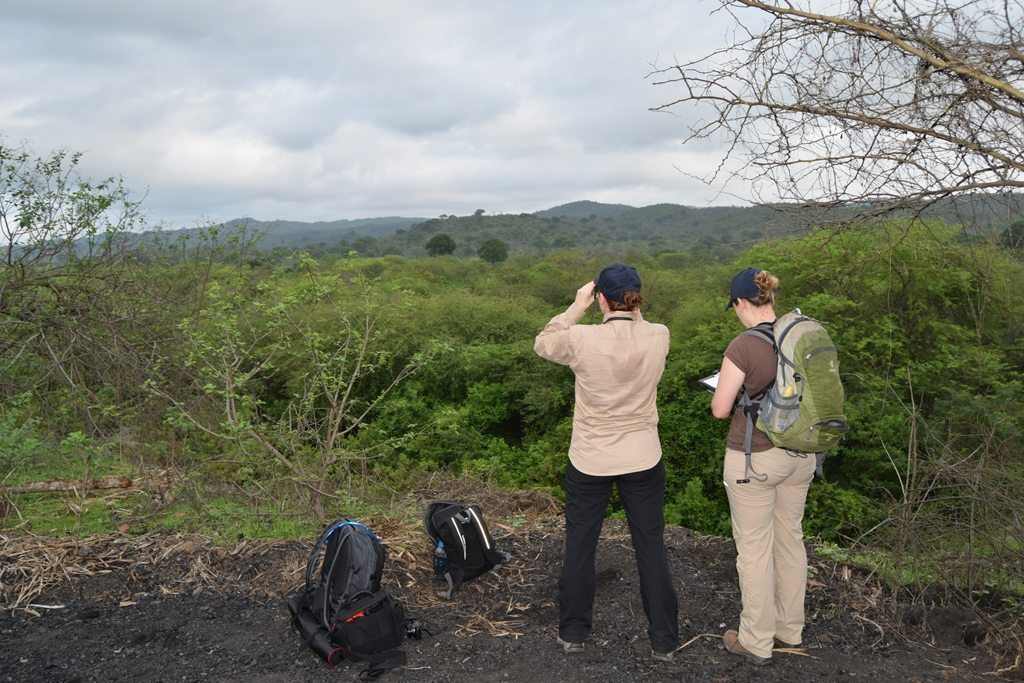
Habitat
One of the things so unique about this parrot species is that it’s a specialist dry forest feeder. Habitat loss is the biggest threat for the survival of the species, only 1% of the dry forest’s original coverage in Ecuador remains. Therefore the team carried out habitat surveys to understand more about the environment the parrot uses and what a dry forest has to be like in order to sustain the species. The team surveyed 178 quadrats of 400m squared each collecting loads of data; including the density of forest, species of trees found there and whether there were any human disturbances, allowing us to track any trends about the areas of forest the parrot is using. The team identified 64 different trees, and which of these the parrots use for feeding, roosting and nesting. This information will help us to predict other forests across the country that the parrot might be found in and identify which areas need protecting for the species to survive into the future.
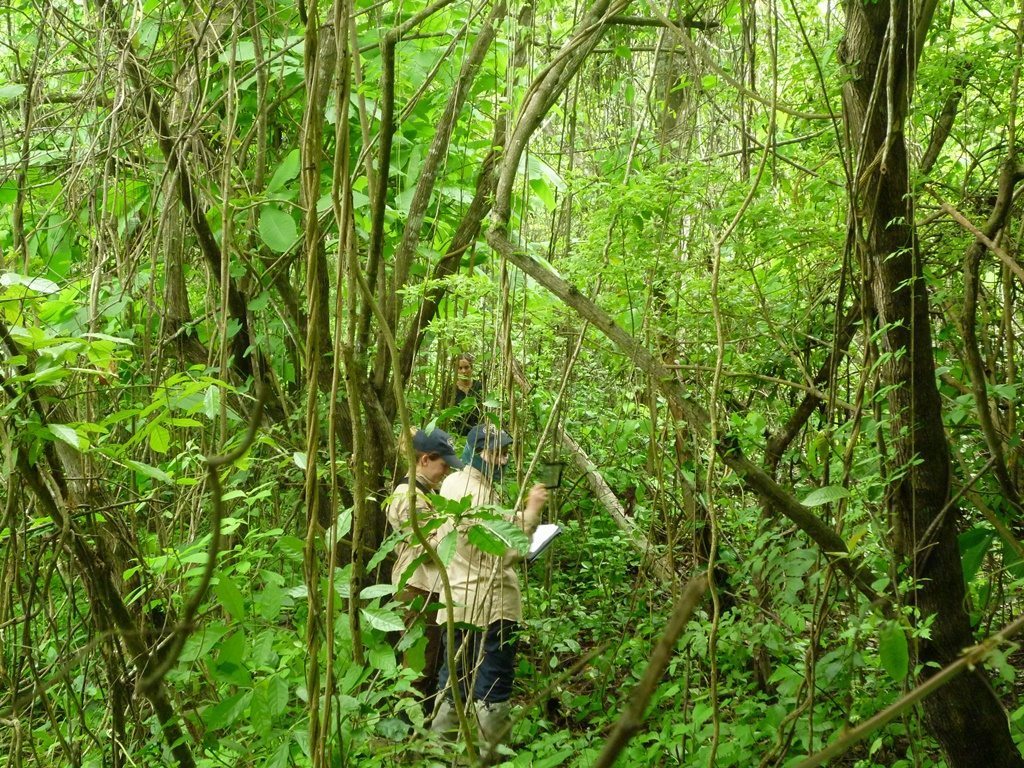
Community surveys
Speaking to the local communities is a really important part of the project as they’re a fountain of knowledge! The parrots are so loud and fly in big groups so it’s quite obvious to the local communities where these parrots can be found. And because the parrots use the same flight path each morning and evening, the local people have a good idea of how many there are, their habitat preferences and other behaviour traits that can help us in mapping the species distribution. It became apparent through the surveys that some people even keep the Ecuador Amazon parrots as pets.
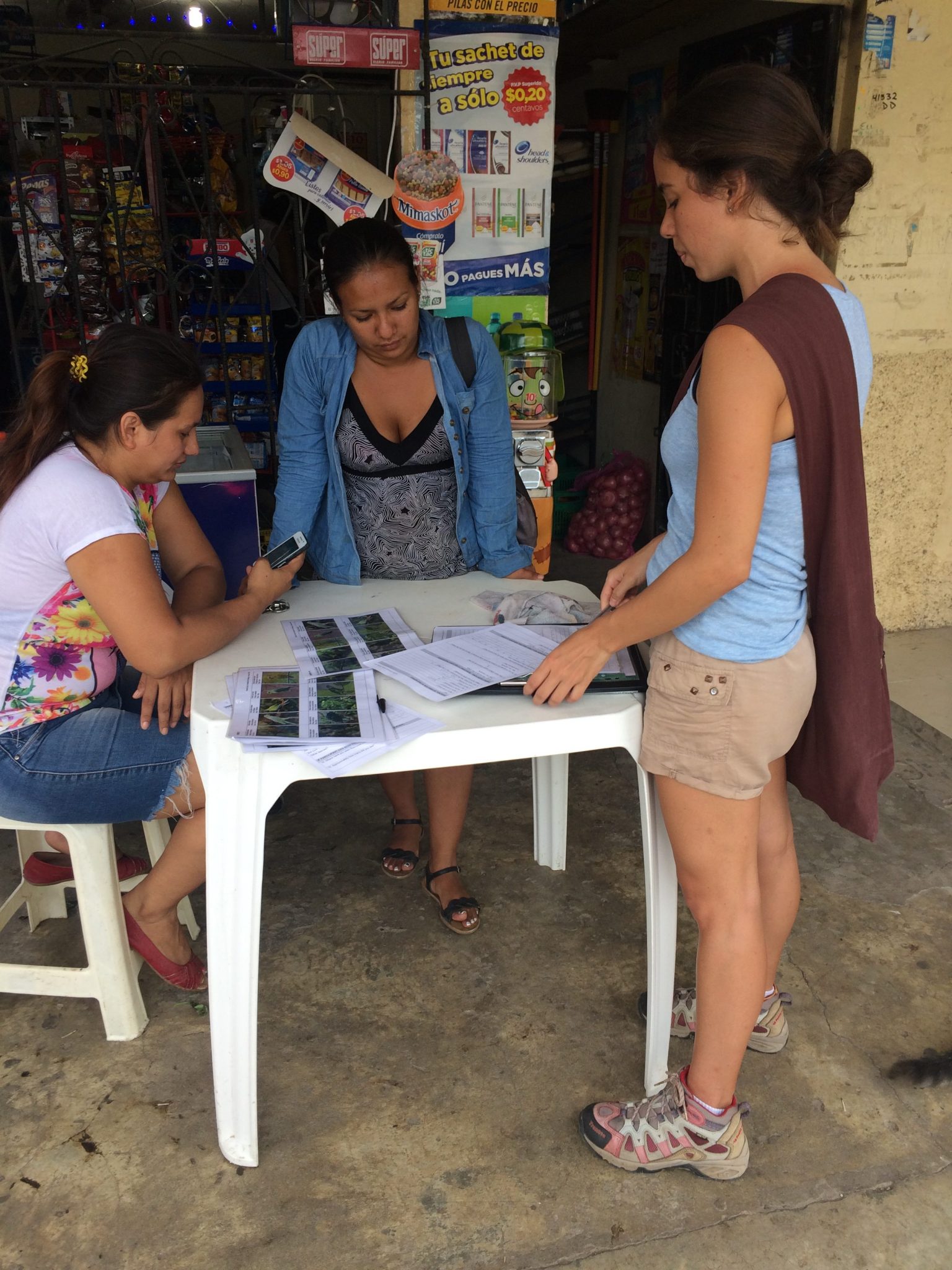
We recently conducted our annual expedition, this time heading to Ecuador to collect vital data on the endangered Ecuador Amazon parrot. The expedition’s objectives were to search for the elusive parrot’s nests, to collect data on their habitat, to conduct roost counts but also to launch the pilot of our first community survey in the region.
In total, the team spent more than 90 hours scrambling through bushes to survey 178 quadrats of 400m² each and 64 different tree species were identified and categorised into feeding, roosting or nesting areas. The community surveys gave some interesting insights on where to find the parrots and also highlighted the fact that a few households in our study area actually keep Ecuador Amazon parrots as pets in their households.

Rebecca Biddle is now conducting her PhD on the endangered parrot and she is analysing the data collected during the expedition. She explains more below:
“At the moment, the scope of my research project is to identify the conservation priorities and to gather the information that we need to put conservation actions into place. That includes a lot of different elements such as the habitat preference, the distribution of the parrots but also the roost counts and the population estimates.”
Working in collaboration with the Fundación Pro-Bosque, an Ecuadorian forest protection NGO, Rebecca realised five years ago that very little was known about the little green parrot. She continues:
“We didn’t know how many of them there were, where they were, how big their range was and what their hotspot within the distribution were. For me it just became apparent that there was a big chunk of questions there that no one knew the answers to!”
Following the pilot community survey done during the expedition, Rebecca has been working with Ivette Solis, a local independent biologist working with Pro-Bosque, to design a new set of more in depth questionnaires.
“The reason to look at the communities initially was to try and get a better picture of the parrot’s distribution but it became apparent during the survey that a lot of people had Ecuador Amazon parrot as pets in their house.”
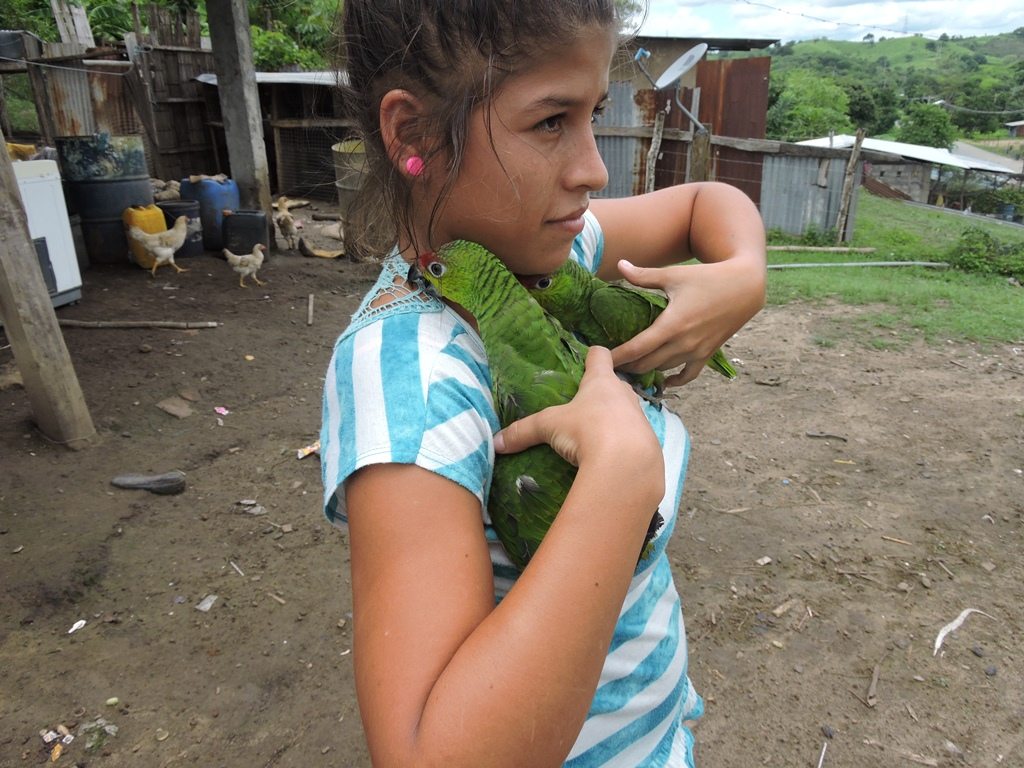
Out of the 90 villages surveyed at least 20 had at least one individual parrot that they would openly talk about. This is why Rebecca and Ivette are now working together to quantify the number of the endangered parrot that might be kept as pets in the region. Their goal is also to assess where the parrots came from, Rebecca explains why:
“We don’t know if they came directly from poaching or if they were brought from different areas so we want to try and work out how many people are poaching them from nests or catching them from roosts and how frequent it is.”
The new survey in addition of quantifying threats will also measure the awareness and knowledge the local communities have of the endangered but locally common species. By assessing their knowledge, the team then aims to highlight the intrinsic value of the species by developing education materials. The key learning messages would include tools to recognise the Ecuador Amazon parrot, information about its role in the dry forest and mangrove but also actions people can take to help its protection.
The Andean bear project was developed by Chester Zoo in partnership with The University of Oxford’s Wildlife Conservation Research Unit (WildCRU) and Bolivian NGO Prometa. This conservation initiative is the first of its kind in Bolivia and aims to study the population dynamics of bears and the drivers of human-bear conflict in the Andean dry forests of Bolivia. So far, the team has deployed 70 camera traps in 35 stations and has collected signs of bear presence such as tree marks, food remains and scats.
Chester Zoo Conservation Fellow Dr Ximena Velez-Liendo is currently in Bolivia studying the Andean bear and she is determined to declare the iconic species as part of Bolivia’s National Natural Heritage. The below video, narrated by Sir David Attenborough, provides an overview of the work Ximena is doing to conserve Andean bears in Bolivia:
To achieve her goal, Ximena has been working with various MPs and other politicians to pass a law, the Ajayu’s law, to protect the Andean bear and ultimately its ecosystem.
Ximena tells us more below:
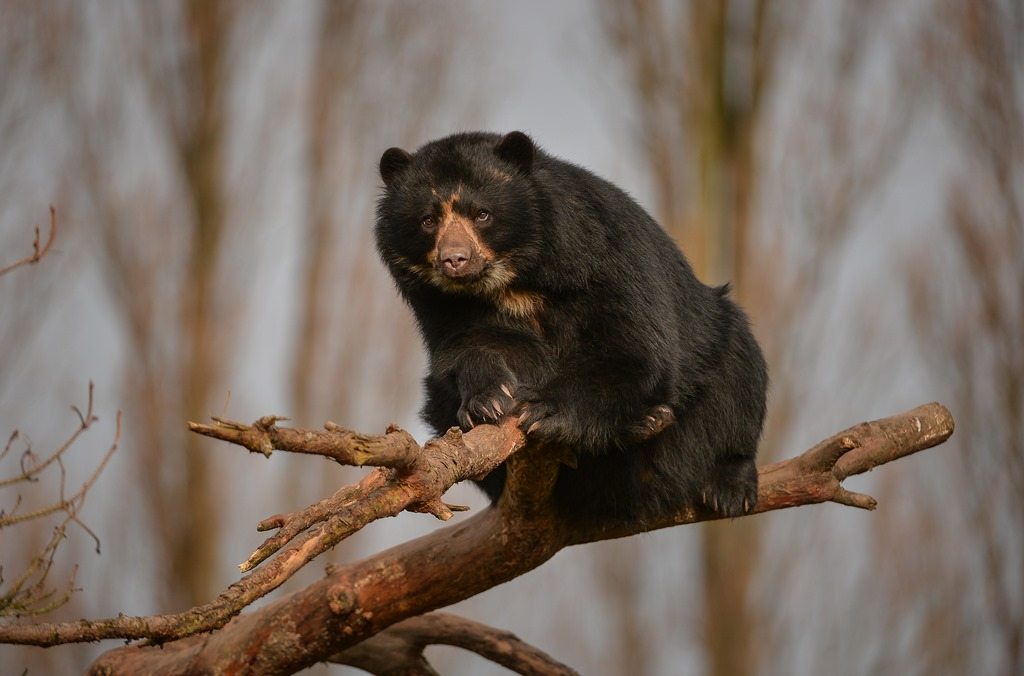
It was a really interesting experience to be in front of MPs and to get the opportunity to explain why this species is so special. At the moment, this law is at the senate where it will hopefully be approved by the President early next year.
Alongside this, Ximena is working with other Bolivian conservationists and the government to develop an Andean bear and jaguar Conservation Action Plan. Ximena has also recently given a TEDx talk in Tarija; below she tells us more about the topics she covered during this talk (which was in Spanish):
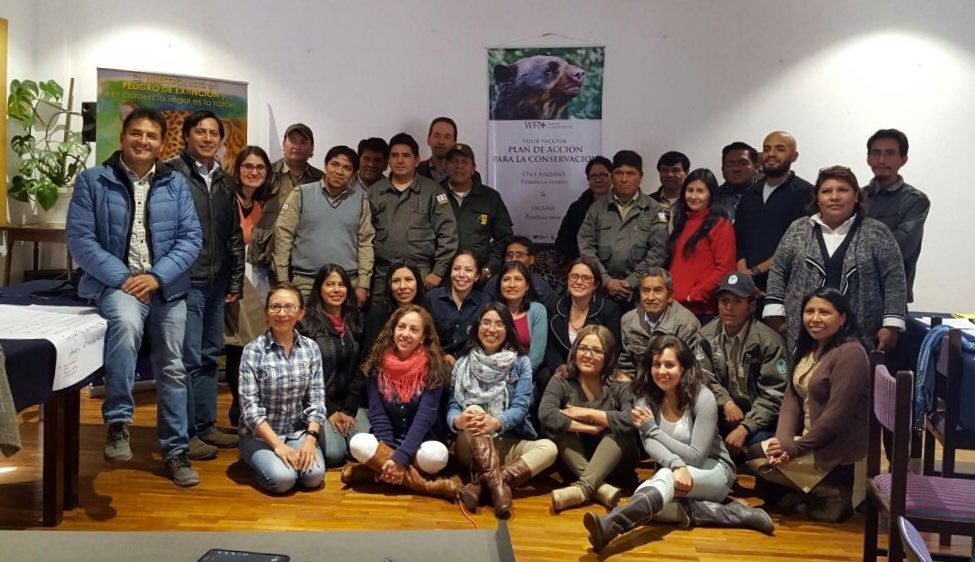
“My talk was about the lessons I learnt from my life as a bear biologist but also about the role that my grandmother played in my life. She always wanted me to travel and see the world. She used to say: ‘Do not stay at home! Go out, travel, gain experiences, meet new people, learn new languages’.
“I also talked about my first encounter with an Andean bear, and how lucky I felt to see one on my very first day in the field. This bear taught me to take things with ease, to move slow, to be patient but he also taught me about resilience, adaptation, and survival.”
Ximena finished her talk by reminding the audience of the important role that the Andean bear plays in the dry forest ecosystem in Bolivia. When a fire burns in the Andean dry forest, the bears will be the ones to disperse seeds, allowing the forest to bloom again. Ximena ended her talk by giving seeds to the audience asking them to go out there and disperse the seeds and become a bear for one day.
We work in 80 countries across the globe to help some of the world’s most endangered animals. Working closely with many organisations we provide both funding and expertise to help the fate of species which are on the edge of extinction.
The Mauritian Wildlife Foundation (MWF) is one of the organisations we work with, helping conserve some of the endangered endemic plant and animal species of the Mascarene islands of Reunion, Mauritius and Rodrigues. These islands are located 700 km east of Madagascar. Back in the 16th century, the first settlers arrived – soon after the last dodo was killed by sailors. Many other species succumbed to the same fate and with introduction of alien species, many native species’ habitats disappeared. Today, the islands have lost most of their native vegetation and the growing human population has put increased pressure on remaining forest fragments. However, over the years some species numbers have increased including the once nearly extinct Rodrigues fruit bat.

Chester Zoo’s Twilight Team Manager and global species co-ordinator for the Rodrigues fruit bat, David White, travelled to the islands. Here he tells us more about his trip:
“The Rodrigues fruit bat was once described as ‘the rarest bat in the world’. In the 1970s the species almost went extinct as numbers dropped to just 70 bats. However ongoing conservation work and habitat protection in Mauritius – which we have supported for a number of years – together with research, education and an effective breeding programme in zoos has since seen the population steadily increase. Yet as the bats are only found in a single location on Rodrigues they are classed as critically endangered by the International Union for Conservation of Nature so monitoring their numbers is imperative. Therefore on my recent visit I worked with the Mauritian Wildlife Foundation to help conduct the quarterly bat counts across the island.
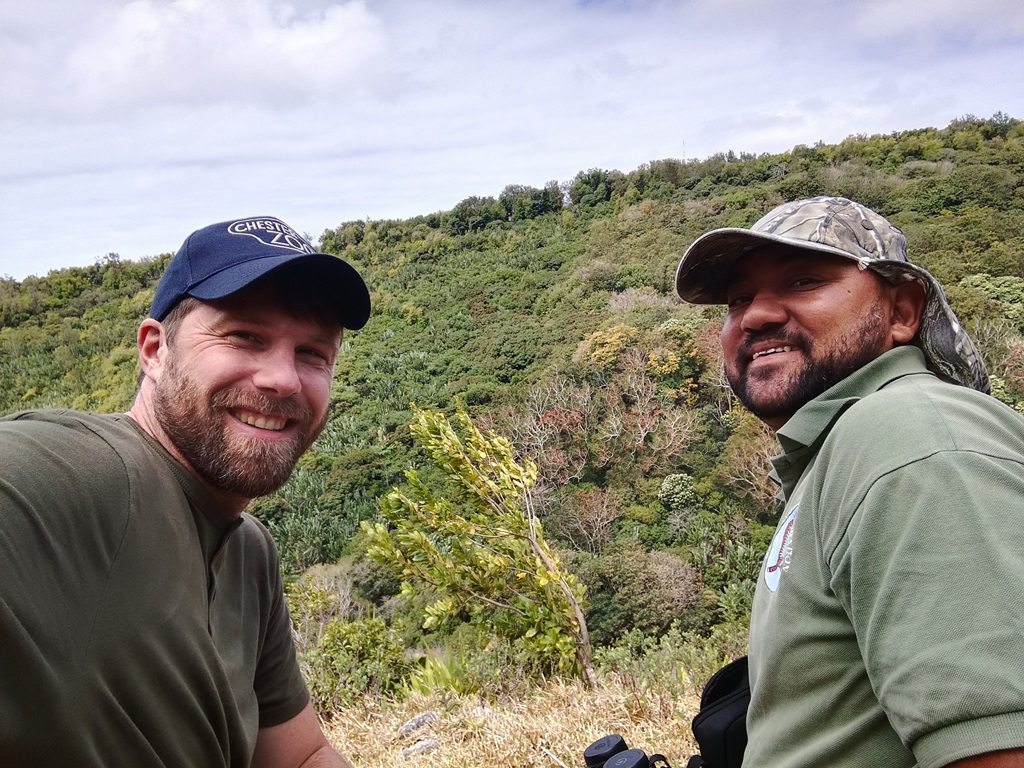
“One of the most breath-taking moments for me was standing at the top of the valley to Cascade Pigeon, one of the largest habitats for the bat on the island, where some 40 years before, the great conservationist Gerald Durrell had witnessed first-hand the plight of the Rodrigues fruit bat. He decided to create an insurance population, the first for this species, in the 1970s to ensure its survival. The founder animals came from the very valley that I saw before me and I now work with their ancestors in Chester.
“I love the Rodrigues fruit bat, they are also known as the Rodrigues flying fox because their elongated muzzles give them a distinctly fox-like appearance. The first time I experienced a wild Rodrigues fruit bat in flight was a little surreal: they looked so majestic and graceful. Roost sites chosen by the bats were in tall trees, situated on steep sided valleys which offered them shelter from the elements. Some of these roosts were very difficult to access due to the steep sided valley and the undulating terrain.
“To get an idea of the wild Rodrigues fruit bat population, evening dispersal counts are carried out simultaneously at each roost across the island. I took part in roost counts in three different locations. It was so peaceful, perched at the top of the cliff overlooking the valley below, bats flying past as they left the roost sites to feed. It really is vital that we succeed in our attempts to conserve this wonderful species.
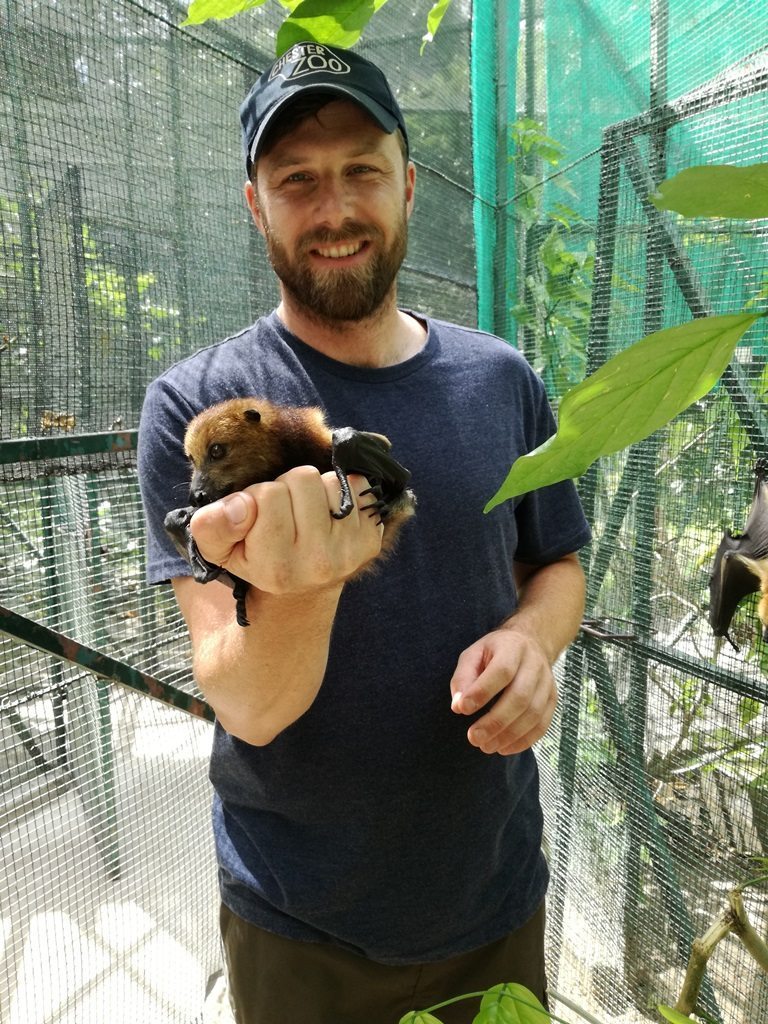

“So how do you conduct a roost count? Well an imaginary line was visualised from the cliff top to a building in the distance. When a bat crossed this line it was counted as leaving the roost; any returning bats were subtracted and the count finished when it was too dark to see any bats. I had the privilege of witnessing some pups, still dependent on their mothers. It still amazes me how the female bats can fly with pups attached to them.
“During my time on Rodrigues Island, I visited the nature reserve Grande Montagne one of the last remaining strands of forest on the island. The reserve has undergone allot of restoration work to help protect the native and unique flora and fauna and the MWF has overseen the planting of over 150,000 native plant species, whilst eradicating invasive ones. The nature reserve also provide crucial habitats for the last three surviving endemic species: the Rodrigues fruit bat, Rodrigues warbler and Rodrigues Fody.
It was a privilege to lend the skills I’ve developed here in Chester to our work in the wild witness first-hand a conservation success story.
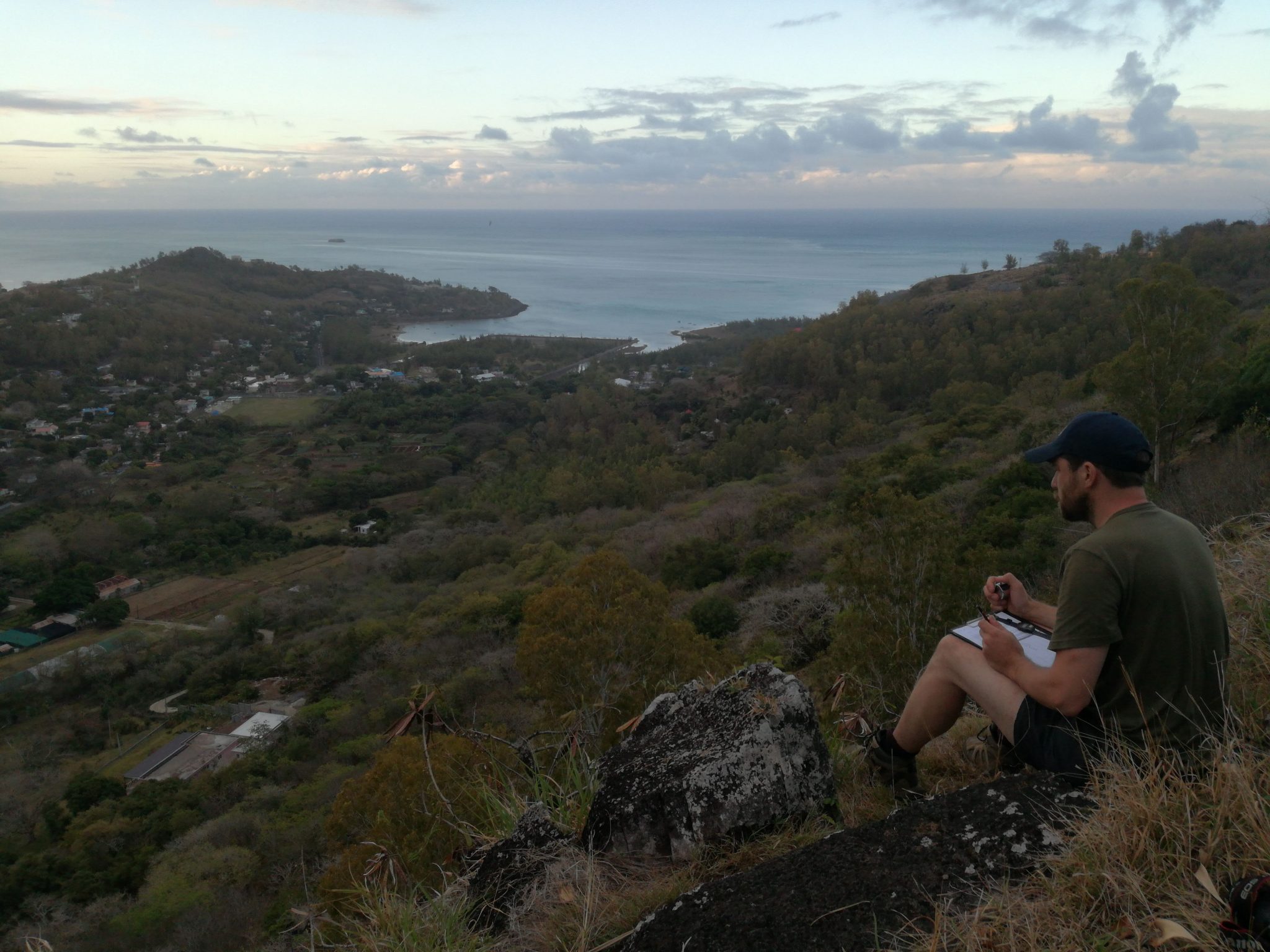
“Back in the 70’s it was believed that this species could disappear in the wild altogether but thankfully due to the perseverance of many different organisations and the start of a very successful breeding programme the number of Rodrigues fruit bat has increased dramatically. I hope that with the brilliant work we support with the MWF the numbers continue to increase and the bats will continue to thrive in their native home.”
Staying in Mauritius
Conservationists, fruit growers, netting experts and government officials gathered for the first time in a joint effort to develop new solutions to resolve conflict between farmers and crop raiding bats.
We support the project, which launched earlier this year, to assess the impact of road-kill on giant anteaters and intend to gain a deeper understanding of the relationship between giant anteaters and roads. This unique animal is known to receive a negative response from the public, potentially explaining the high number of road-kills recorded.
The project carries out road surveys to register the number of giant anteater victims of road incidents and also giant anteater expeditions, where individuals are measured and equipped with GPS harnesses. This allows the team to collect vital data on their distribution and assess the risk associated with the nearby highway.
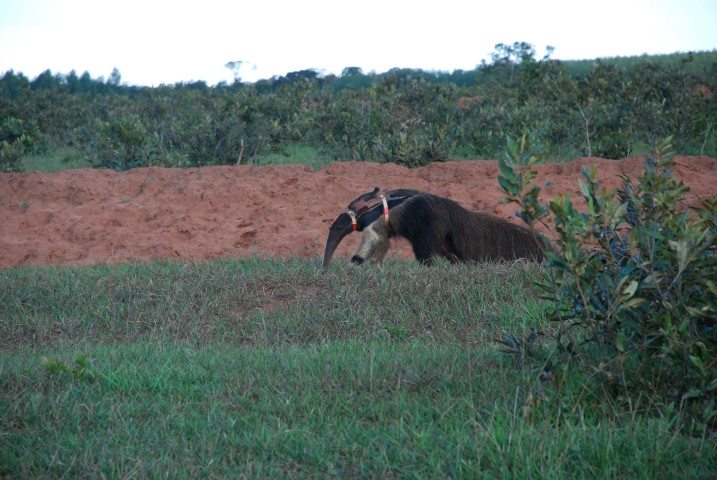
Since its start in mid-January, the road-kill study surveyed a total of 13,985km and recorded a staggering number of 1,242 dead animals! That’s equivalent to one dead animal every 11km surveyed! Six-banded armadillos, giant anteaters and Southern tamanduas were among the most killed with respectively 171,131 and 75 individuals counted.
But it’s not all doom and gloom! The various expeditions were very successful with a total of 19 giant anteaters captured. Reflective tape was glued to the GPS collars with the hope that it would increase their chances of survival if and when they cross the highway. The goal for 2018 is to catch 20 more anteaters in a new study area.
To honour our long term partnership, the Anteaters and Highways team decided to name one of the males they captured, Chester. Chester is 29kgs and was caught only 500 metres away from the highway. In the past few weeks Chester has crossed the highway safely, providing valuable information on when and how a giant anteater cross roads.
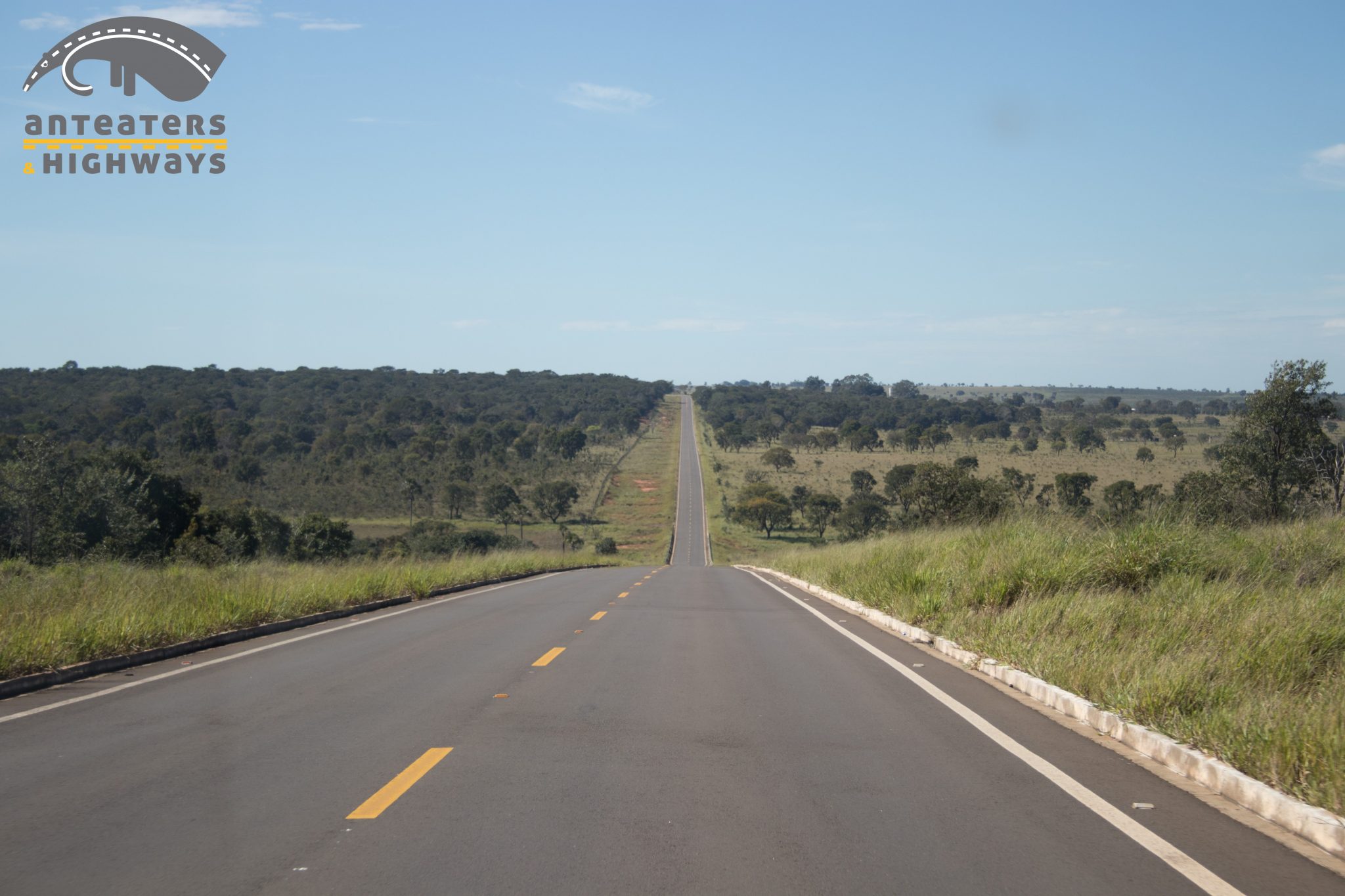
The team have also started a camera trap grid to estimate the density of giant anteaters near and far from roads. Data collected by this activity will be valuable throughout the species distribution.
We’re also excited to share that one of the female giant anteaters the team have been monitoring gave birth. This female, called Bumpus, lives about 3km from the highway. She has never crossed the road; she and her baby should be safe. Five of the other individuals are crossing the highway frequently, which is a major cause for concern. The team will continue to carry out surveys of highways with the support of local volunteers and students.
Other research objectives of the Anteaters and Highways Project are also progressing well. PhD student Mari Catapani has recently finished her first round of interviews with truck drivers to try and gain an understanding of their perceptions regarding roadkill, in particular giant anteaters. This will support in the development of mitigation strategies. There are many negative superstitions regarding giant anteaters too.
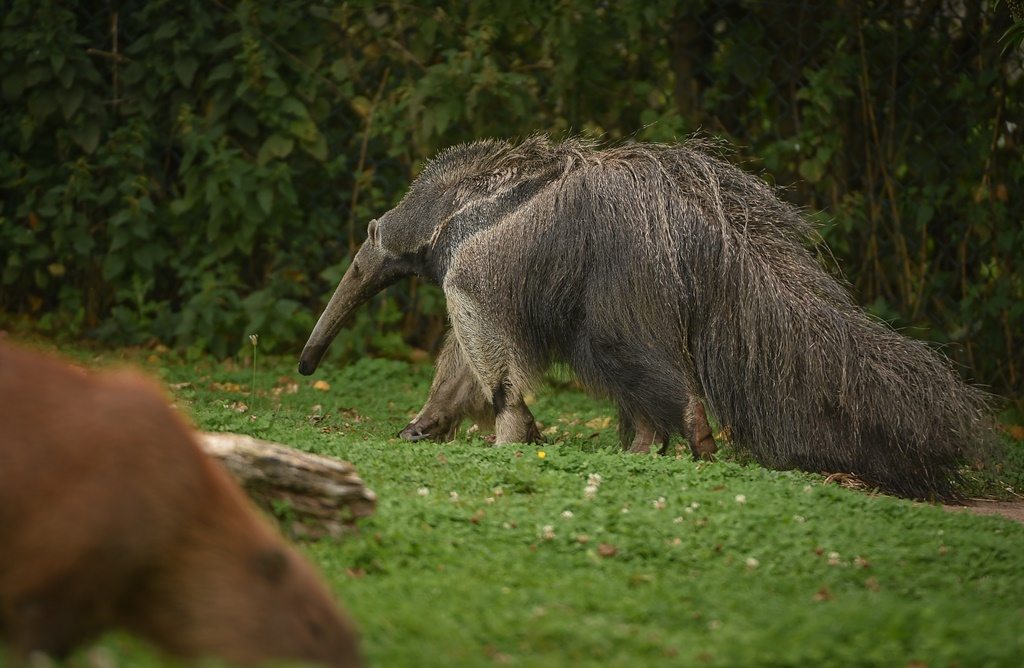
Vinicius Albereci will also be starting a PhD field work with the Anteater and Highways project, evaluating impacts of roads using camera traps and occupancy models. Vinicius has been awarded the new Nat Geo Photo Ark Edge fellowship from our colleagues at ZSL to help conduct this work. This is very exciting and will be huge help to the Anteaters and Highways Project.
Watch this space for more updates from the project as it continues to progress and develop further in order to protect the giant anteater from extinction. Read more about the project, here >
Researchers on the island of Java have discovered populations of an almost extinct species that is regarded as the “world’s ugliest pig”. The population of the Javan warty pig, listed as endangered by the International Union for the Conservation of Nature (IUCN), is estimated to have decreased by as much as 50% since 1982.
It was even feared that many, if not all, populations of the Javan warty pig had become extinct until their existence was confirmed by our camera traps. The plight of the animals reveals the cost of hunting and the destruction of forest habitat in Indonesia.
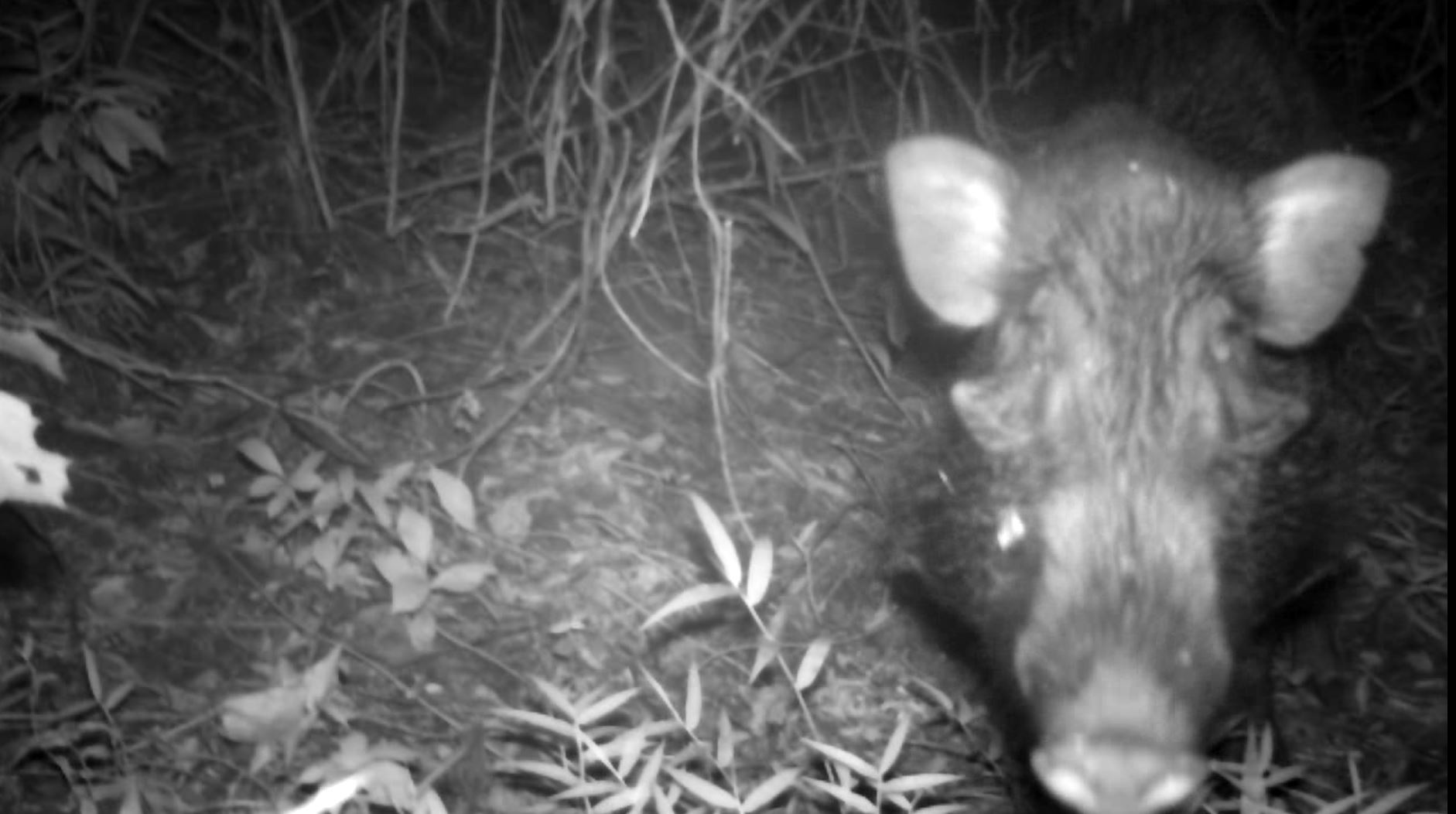
The scientific research we’re supporting, is working to understand the little known animals and any steps that need to be taken in their long-term conservation. It could eventually be used to establish new protection laws for the species as currently they’re not protected by Indonesian law.
Dr Johanna Rode-Margono, South East Asia Field Programme Coordinator at Chester Zoo, designed the study to try and locate the last Javan warty pigs alongside Indonesian researcher and Project Manager Shafia Zahra. Johanna tells us more below:
“Javan warty pigs are of a similar body size to European wild boar but are a bit more slender and have longer heads. Males have three pairs of enormous warts on their faces. It is these characteristics that have led to them being affectionately labelled as ‘the world’s ugliest pig’ but, certainly to us and our researchers, they are rather beautiful and impressive.
Indeed the Javan warty pig is a special animal. They are unique and can only be found in Java. Little is known about them and that very fact means we need to preserve them. We just don’t know what havoc it could wreak for other wildlife if they go extinct.
Watch the below interview with Shafia, which also includes some of the first ever wild footage our cameras captured of the Javan warty pig, to discover more about the research she’s been carrying out in Java below:
Out of the seven locations surveyed by Shafia, across Java between June 2016 and May 2017, only four sites were found to have pig present, meaning that the species is highly likely to be extinct in the other three.
The second phase of the project is now underway to try and estimate the exact population size of the Javan warty pig and assess the impact that hunting is having on the species.